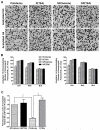Effects of histone deacetylase inhibitors on amygdaloid histone acetylation and neuropeptide Y expression: a role in anxiety-like and alcohol-drinking behaviours
- PMID: 24528596
- PMCID: PMC4140694
- DOI: 10.1017/S1461145714000054
Effects of histone deacetylase inhibitors on amygdaloid histone acetylation and neuropeptide Y expression: a role in anxiety-like and alcohol-drinking behaviours
Abstract
Recent studies have demonstrated the involvement of epigenetic mechanisms in psychiatric disorders, including alcoholism. Here, we investigated the effects of histone deacetylase (HDAC) inhibitor, trichostatin A (TSA) on amygdaloid HDAC-induced histone deacetylation and neuropeptide Y (NPY) expression and on anxiety-like and alcohol-drinking behaviours in alcohol-preferring (P) and -non-preferring (NP) rats. It was found that P rats displayed higher anxiety-like and alcohol-drinking behaviours, higher amygdaloid nuclear, but not cytosolic, HDAC activity, which was associated with increased HDAC2 protein levels and deficits in histone acetylation and NPY expression in the central (CeA) and medial nucleus of amygdala (MeA), as compared to NP rats. TSA treatment attenuated the anxiety-like and alcohol-drinking behaviours, with concomitant reductions in amygdaloid nuclear, but not cytosolic HDAC activity, and HDAC2, but not HDAC4, protein levels in the CeA and MeA of P rats, without effect in NP rats. TSA treatment also increased global histone acetylation (H3-K9 and H4-K8) and NPY expression in the CeA and MeA of P, but not in NP rats. Histone H3 acetylation within the NPY promoter was also innately lower in the amygdala of P rats compared with NP rats; which was normalized by TSA treatment. Voluntary ethanol intake in P, but not NP rats, produced anxiolytic effects and decreased the HDAC2 levels and increased histone acetylation in the CeA and MeA. These results suggest that higher HDAC2 expression-related deficits in histone acetylation may be involved in lower NPY expression in the amygdala of P rats, and operative in controlling anxiety-like and alcohol-drinking behaviours.
Figures





Similar articles
-
Potential role of adolescent alcohol exposure-induced amygdaloid histone modifications in anxiety and alcohol intake during adulthood.Neurobiol Dis. 2015 Oct;82:607-619. doi: 10.1016/j.nbd.2015.03.019. Epub 2015 Mar 24. Neurobiol Dis. 2015. PMID: 25814047 Free PMC article.
-
Aberrant histone deacetylase2-mediated histone modifications and synaptic plasticity in the amygdala predisposes to anxiety and alcoholism.Biol Psychiatry. 2013 Apr 15;73(8):763-73. doi: 10.1016/j.biopsych.2013.01.012. Epub 2013 Feb 26. Biol Psychiatry. 2013. PMID: 23485013 Free PMC article.
-
Histone deacetylases (HDAC)-induced histone modifications in the amygdala: a role in rapid tolerance to the anxiolytic effects of ethanol.Alcohol Clin Exp Res. 2012 Jan;36(1):61-71. doi: 10.1111/j.1530-0277.2011.01581.x. Epub 2011 Jul 25. Alcohol Clin Exp Res. 2012. PMID: 21790673 Free PMC article.
-
[Epigenetic mechanisms and alcohol use disorders: a potential therapeutic target].Biol Aujourdhui. 2017;211(1):83-91. doi: 10.1051/jbio/2017014. Epub 2017 Jul 6. Biol Aujourdhui. 2017. PMID: 28682229 Review. French.
-
Epigenetic basis of the dark side of alcohol addiction.Neuropharmacology. 2017 Aug 1;122:74-84. doi: 10.1016/j.neuropharm.2017.02.002. Epub 2017 Feb 4. Neuropharmacology. 2017. PMID: 28174112 Free PMC article. Review.
Cited by
-
Transcriptional Regulators as Targets for Alcohol Pharmacotherapies.Handb Exp Pharmacol. 2018;248:505-533. doi: 10.1007/164_2018_101. Handb Exp Pharmacol. 2018. PMID: 29594350 Free PMC article.
-
Histone deacetylases mediate GABAA receptor expression, physiology, and behavioral maladaptations in rat models of alcohol dependence.Neuropsychopharmacology. 2018 Jun;43(7):1518-1529. doi: 10.1038/s41386-018-0034-8. Epub 2018 Feb 27. Neuropsychopharmacology. 2018. PMID: 29520058 Free PMC article.
-
Integration of peripheral transcriptomics, genomics, and interactomics following trauma identifies causal genes for symptoms of post-traumatic stress and major depression.Mol Psychiatry. 2021 Jul;26(7):3077-3092. doi: 10.1038/s41380-021-01084-3. Epub 2021 May 7. Mol Psychiatry. 2021. PMID: 33963278
-
Ethanol actions on the ventral tegmental area: novel potential targets on reward pathway neurons.Psychopharmacology (Berl). 2018 Jun;235(6):1711-1726. doi: 10.1007/s00213-018-4875-y. Epub 2018 Mar 16. Psychopharmacology (Berl). 2018. PMID: 29549390 Free PMC article. Review.
-
Effects of acute ethanol exposure on anxiety measures and epigenetic modifiers in the extended amygdala of adolescent rats.Int J Neuropsychopharmacol. 2014 Dec;17(12):2057-67. doi: 10.1017/S1461145714001047. Epub 2014 Jun 26. Int J Neuropsychopharmacol. 2014. PMID: 24968059 Free PMC article.
References
-
- Badia-Elder NE, Stewart RB, Powrozek TA, Roy KF, Murphy JM, Li T-K. Effect of neuropeptide Y (NPY) on oral ethanol intake in Wistar, alcohol-preferring (P), and -non preferring (NP) rats. Alcohol Clin Exp Res. 2001;25:386–390. - PubMed
-
- Bell RL, Rodd ZA, Lumeng L, Murphy JM, McBride WJ. The alcohol-preferring P rat and animal models of excessive alcohol drinking. Addict Biol. 2006;11:270–288. - PubMed
-
- Broide RS, Redwine JM, Aftahi N, Young W, Bloom FE, Winrow CJ. Distribution of histone deacetylases 1-11 in the rat brain. J Mol Neurosci. 2007;31:47–58. - PubMed
Publication types
MeSH terms
Substances
Grants and funding
LinkOut - more resources
Full Text Sources
Other Literature Sources
Medical
Research Materials
Miscellaneous

